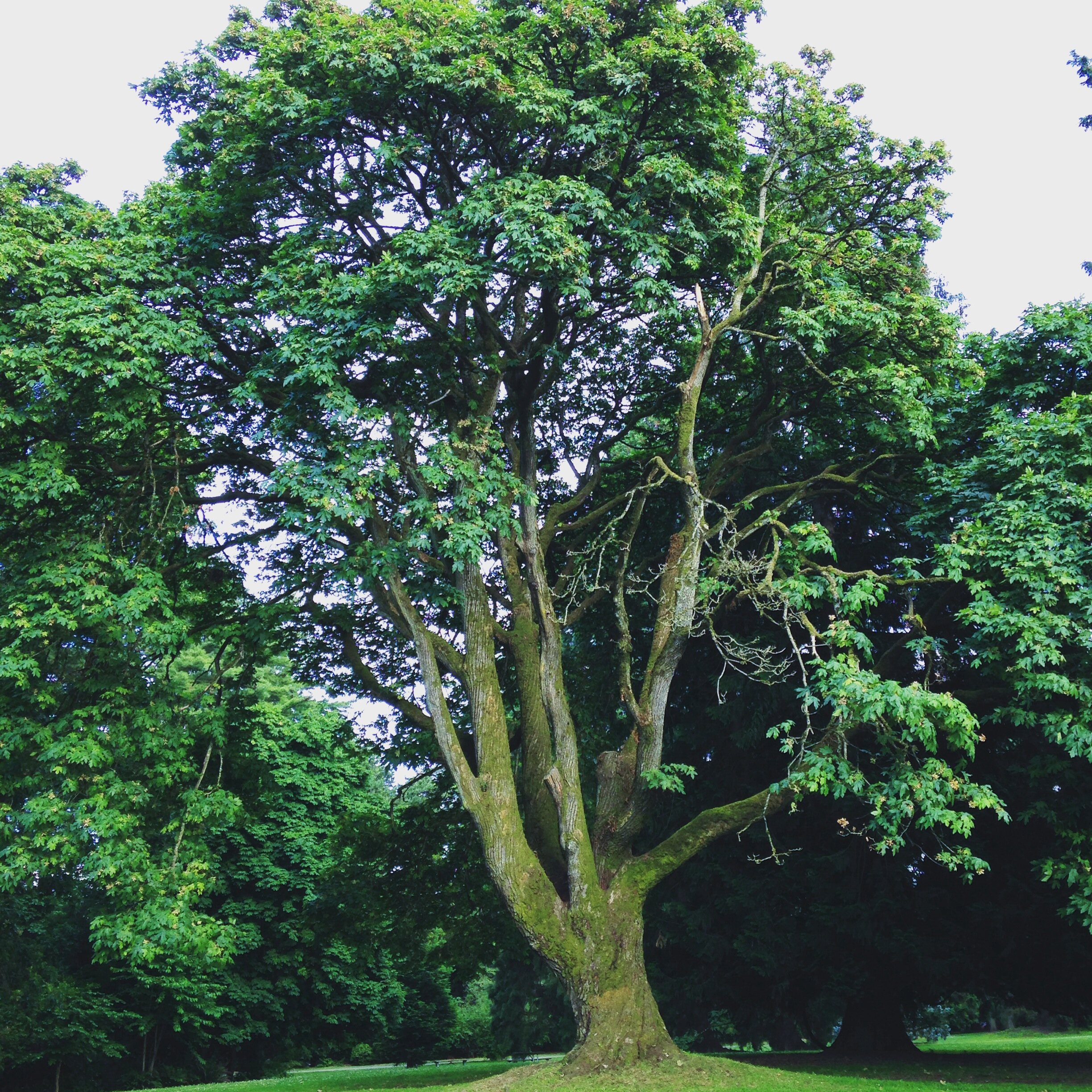Maple trees. My neighborhood. Capitol Hill, Seattle. The oldest neighborhood in the city.
Seattle is called the Emerald City for a reason.
Everything right now outdoors is green. Lush green. Several nature palettes of lush green.
Chlorophyll filled green. Life-filled green.
“Green is the prime color of the world, and that from which its loveliness arises.” Pedro Calderón de la Barca, Poet, 17th Century, Spain.”
Color is a function of light. Or alternatively, light is a function of color as white light contains all the spectrums of color. When white light passes through a prism, the different colors of light travel at different speeds inside the glass prism due to their wavelength frequency. Violet travels the slowest so it is on the bottom of the color bands and red travels the fastest so is on the top. Green is a medium wavelength frequency and travels in the middle of the light pack.
The color green is abundant in nature, as the most common plant pigment is chlorophyll. Chlorophyll absorbs certain wavelengths of light (color) and reflects green light, making the plant/foliage appear green.
Arboretum, Lake Washington, Seattle. University of Washington Husky Stadium in the background (left.) September 2020.
Volunteer Park (an Olmsted legacy park,) Seattle. c 2013. Chlorophyll in the grass reflects green light even in the fog.
Bigleaf Maple, Volunteer Park. 2015.
Volunteer Park, Lily Pad Pond and ducks. May 2021.
Lily Pad Pond, Volunteer Park. Originally displayed at Seattle Art Museum SAM Gallery, 2017. Seattle. Oil on Canvas, 24x24.” 2017.
Color Wheel. Charles Blanc, approx. 1879. France.
Shades of chartreuse, yellow, and blues are mixed together to form different hues and values of green depending on if the sun shines through the foliage or if the foliage is is shaded, essentially, how much green light is reflected.
On the color wheel, yellow and blue combine to make green. So there is a lot going on when it comes to the describing color.
A few days ago over the Memorial Day weekend, I was cycling along Lake Washington Boulevard that was closed to automobile traffic during the day for the 3-day weekend. My mission: I was on a hunt for an Olmsted-legacy park in Seattle called Frink Park (constructed approx. 1906-1911,) a 17.2 acre greenspace in the Leschi neighborhood of Seattle near Lake Washington.
Depending where you are located on Lake Washington Boulevard, you will get an amazing view of Mount Rainier that looms over the lake. View of Mount Rainier from Seward Park. May 2021.
Heading north, entrance ahead to Frink Park, Lake Washington Boulevard. Lake Washington is down below to the right from this viewpoint.
I was lulled to Frink Park by the prospect of doing some sketching of a very picturesque bridge in the park with the end goal to make a painting of the setting one day.
I looked at my map app on my iPhone to guide me. What is so interesting is that the park appeared out of nowhere. In one instance, I am in the lake side neighborhood of Leschi, which has a lovely, unique boat-y character all of its own. Sailboats are moored in several boat docks all along the lake. If they are not moored, they are out on the lake, making strides on the 21-mile long Lake Washington, sometimes sharing swaths of the lake with power boat traffic.
As I cycle northbound on Lake Washington Boulevard, I cross over from one world to another. In one moment, I am cycling on a city street lined with homes with the occasional basketball hoop set up on curbside. Quaint, quiet, and suburban-esque. Then all of a sudden, the housing stops and the urban green space begins. A gigantic canopy of green envelopes my realm, towering hundreds of feet over my head. The temperature dipped a few degrees from about 70 to about 66 or so as I enter into the green shaded canopy. I could smell the bark of the shade dampened old growth wood. Pretty cool!
Then, in about 200 feet, I came across my destination. It was quite unsuspecting.
A small path of the road was supported by the bridge in Frink Park. I arrived!
From this point, about 50 feet from the road, I could see in the distance a wooden footpath. I disembarked from my bike and walked it down the dirt path. I sat down for a brief while on the wooden bridge to sketch accompanied by the gently running waters of a brook that runs under the bridge. This is a Zen experience that I very much needed. And well worth the time to discover.
Here is my sketch.
Sketch, May 2021. Bridge, Frink Park, Seattle.
With regards to the color green that is ubiquitous, here are some more paintings I made in the past years of Seattle landscape scenery. Green is prevalent everywhere.
Kubota Garden, Seattle. Oil on Canvas, 4x4” each. 2018.
Kubota Garden, Heart Bridge. Watercolor sketch, postcard, 4x6.” 2020.
Interlaken Park, and Olmsted legacy park. North Capitol Hill, Seattle. Oil sketch, 5x7.” 2021.
Mary Lamery is a lifelong resident of Seattle, Washington, USA and native of the Pacific Northwest.
Lamery paints regional landscape in a manner that leans towards 19th century French Impressionism.
Her landscapes invite the viewer to add to the backstory of the composition through personal identification with the paintings and story telling of the experience.
Follow Mary on Instagram.














